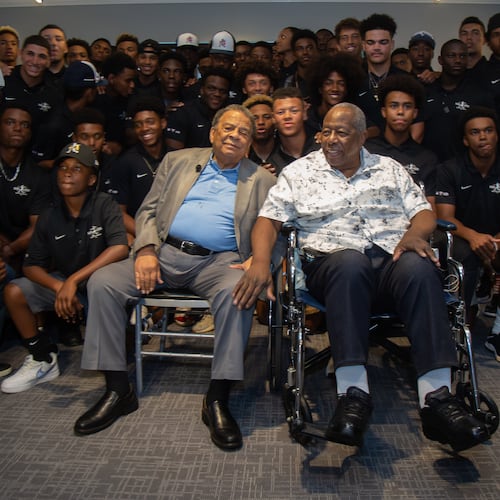Cars spun out without so much as a nudge, sending the cars behind them spilling across the track like someone tipped over a jar of marbles.
Other times, drivers squeezed in gaps to make thrilling passes and seize the lead, only to give it back up soon after.
At pit stops, crew members taped up hoods and bumpers like running backs with tweaked ankles.
And, at the last, three cars roared to the Atlanta Motor Speedway finish line dead even, with the winner of the Ambetter Health 400 won by an impossibly narrow margin by an immigrant from Mexico living out a dream that only the coldest heart couldn’t appreciate.
Even a neophyte to the sport could embrace the craziness that unfolded at Sunday’s race, to say nothing of how a veteran driver experienced it.
“It was fun,” said driver Chase Briscoe, who finished 31st. “That was the most fun I’ve ever had here.”
Worth noting about the fun-having Briscoe – not only did he not win, but he didn’t even finish the race. In lap 240 of 260, he wrecked after losing control of his Ford Mustang while squeezed in between three other drivers close enough to reach into each other’s glove boxes.
“Guys were just making huge moves and big runs and we were able to not get close to crashing a lot of times like we would at Daytona or Talladega,” Briscoe said.
The 1.54-mile track, redone in 2021 with more steeply banked corners and a fresh coat of asphalt, did fans solid Sunday. Wrecks, lead changes, a tight finish – it had it all.
“It was definitely chaotic,” said driver Todd Gilliland, who led the race for 58 laps, most in the field, but finished 26th. “My car was on edge. Every single car was on edge.”
The winner, Daniel Suarez, was part of a Lap 2 wreck (caused by Gilliland) that swept up 16 cars. His hood was bent around the radiator exit ducts. The car was taped back together and sent back onto the track.
So there was that, along with cars not being able to keep all four tires on the track as they ducked in and out of processions of cars hurtling forward at about 180 miles per hour, swallowing up 1 1/2-mile laps in about 30 seconds. Of the 37 cars that started, at least 30 were involved in a wreck, according to the Fox broadcast late in the race.
“We were not comfortable,” Suarez said.
There were 48 lead changes, a record for Atlanta Motor Speedway for a NASCAR Cup series race, with 14 different drivers leading for at least one lap.
By comparison, in the five NASCAR Cup races before the track was renovated, there were an average of 18.4 lead changes, according to racing-reference.info. In the five since the reconfiguration, the average is 31.8.
“Just from an entertainment value, it was an incredible race,” said Justin Marks, owner of Suarez’ victorious Trackhouse Racing team.
The drama began even before the engines were cranked. Defending race champion Joey Logano’s bid to repeat was foiled by, of all things, his attempt to circumvent the rules with an aerodynamic left glove.
Logano drove in qualifying with his right hand on the wheel and his wind-cheating left hand (sheathed in a glove that had not been approved for NASCAR safety standards) up against the window netting.
Logano is to be saluted for his inspired attempt to extend the NASCAR tradition of subterfuge, though we’ll always be left to wonder what sort of insane speeds he could have achieved if he had been able to stick his hand out the window and wave it up and down like a dolphin. Penalized with a start at the back of the pack, Logano managed to maneuver his way into the lead for 27 laps but finished 28th.
The winner Suarez led for only nine laps, but one of the nine was the most important one. In a wild finish, Suarez, Ryan Blaney and Kyle Busch raced side-by-side in the final lap, deadlocked. Suarez reached the finish line literal inches ahead of Blaney, separated by .003 seconds.
To call it a blink of an eye is an insult – that takes at least .1 seconds. It’s like comparing a TikTok video to Titanic.
The 32-year-old Suarez was a popular winner among drivers. When he was 19, he moved from Monterrey, Mexico, to the U.S. with a dream of becoming a champion NASCAR driver. He came alone, didn’t speak English, had no friends and didn’t have money. He learned English by watching movies and cartoons.
Said Marks, “He’s a favorite because people just know how bad he wants it and how hard he works and how appreciative he is of being here.”
Sunday, Suarez didn’t sugarcoat the difficulty of his journey.
“You really have to come from a different place to understand what I had to go through to be able to get here,” he said.
Suarez moved up the ranks, winning the minor-league Xfinity Series title in 2016 and becoming the first Mexican-born driver to win a NASCAR national series race. Sunday was his second win on the major-league circuit.
“At the end of the day, all these difficult times is what makes me who I am today,” he said. “I’m a hard-work person, a person that doesn’t give up, a person that’s always grinding, a person that’s always trying to get better.”
Speaking with media after the race, he said in that moment he was very happy with winning and the performance of his team.
“And (Monday), I guarantee I’m going to watch the race and I’m going to write down a few things I could have done better,” he said. “Because I know that, for the next time we come here, if I do the same thing, probably I won’t win the race. I’m going to have to do better. And everyone else is going to do the same thing. So that is the mentality that you have to have.”
That and a lot of tape.
About the Author
The Latest
Featured

